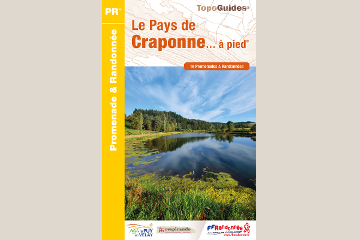The guidebook of Craponne
Released in April 2017, the Topoguide of the Pays de Craponne includes 16 tracks of walks to roam for a day or half a day. For each walk of the guidebook, you will then have:
- detailed IGN maps,
- description step by step of the walk,
- useful iformation (mileage, difference in height, parking lot, etc.),
- points of interest about the tracks,
- thematics sheets (about the fauna, flora or the region’s heritage).
Of a size of 13.5 x 21 cm, the guidebook has the perfect format to discover a territory as a whole.
> To get the guidebook of the Pays de Craponne, go to our online shop, in the section “randonnée à la journée”.
Nature and breath of air
The Land of Craponne is situated in the North of Haute-Loire, at the heart of a vaste granitic plateau, and in the South of the Livradois-Forez Regional Natural Park. The altitude varies between 700 and 1000 meters. Thus, the climate is characteristic of the medium mountain and offers to the residents a breath of fraish air during the periods heatwaves. The protected nature and the fresh air are a delight for everyone. The water is also a major element of the local heritage with 65 kilometers of streams and rivers which travel across the land of Craponne.
Numerous rivers
The Arzon and Ance are two of the most important waterways and carve the edges of the plateau into deep valleys. In the first place, between Chomelix and Vorey, the Arzon weaves at the bottom of the wild gorges. It is then the meeting point for all the trouts’ fishermen and lovers of sports hikes. Then the Ance is, on the other hand, really appreciated by the fly fishers, particurlarly in the South of Saint-Julien-d’Ance.
Via Bolena and Caesar’s way
Many ancient ways cross the country. Among them, the Via Bolena, pre-celtic way joining the Forez to the Languedoc while crossing cities and little villages; and hte way of Caesar, strategic roman way linking Lyon to Toulouse, which, it, avoid thoroughly those little villages. Hence, the impressive star of pre-celtic itineraries spreading around Craponne attests to the antiquity of the occupation of the place.










